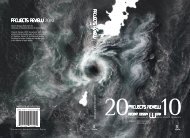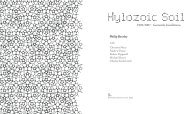The Inner Studio - Riverside Architectural Press
The Inner Studio - Riverside Architectural Press
The Inner Studio - Riverside Architectural Press
You also want an ePaper? Increase the reach of your titles
YUMPU automatically turns print PDFs into web optimized ePapers that Google loves.
PART FIVE | USING THIS LIFE TO BE CREATIVE AND WISE<br />
“Form follows function” has probably become the world’s bestknown<br />
modern design strategy. Broadly interpreted, it suggests that<br />
a thing, whether it is at the scale of a building or a kitchen appliance,<br />
is in some essential way like skin draped over action; it is<br />
designed from its function outward. This complex and elegant<br />
thought has been a central idea of modernism since it was first<br />
uttered by Louis Sullivan more than 100 years ago. Around the<br />
same time, Carl Jung presented a way of understanding personalities<br />
called the Four Functions. His proposal went on to form the<br />
basis of the Myers Briggs Test. Jung’s approach offers a psychological<br />
approach to function that explores how we innately approach<br />
life’s challenges. One proposition sees form residing in the function<br />
of the building; the other would see design residing in the way the<br />
personality functions. No two individuals will approach a problem<br />
the same way. Everyone has their own way to be creative and to<br />
understand things. <strong>The</strong> purpose of the Four Functions is to help<br />
you get to know your own best way to approach things.<br />
About a third of the way into a design project, two students were<br />
stuck. Jason had no difficulty in organizing all the elements of the<br />
project in a reasonable way. He had thought about the parts of the<br />
building and had arranged everything logically. <strong>The</strong> building functioned<br />
well enough, but he really couldn’t say very much about the<br />
life of the building. <strong>The</strong> plan of the building had become a diagram.<br />
He knew the best place to locate most things, but not how the daily<br />
rituals of living would breathe life into the place and give it its<br />
special character. <strong>The</strong> human side of the design was a mystery to him.<br />
Jean had developed a much less obvious plan, but she was<br />
overflowing with feelings about the project and enthusiastically<br />
imagined all kinds of wonderful settings for social intercourse<br />
throughout the building. It became obvious, however, that none<br />
of these were going to be realized because she couldn’t bring any<br />
thinking to help her structure all the wonderful ideas she had.<br />
Both Jason and Jean were stuck: they knew their projects<br />
lacked something, but they didn’t know how to incorporate or<br />
activate the missing component. Jean’s project embodied what<br />
was missing from Jason’s project. Jason had all the clarity that<br />
143





